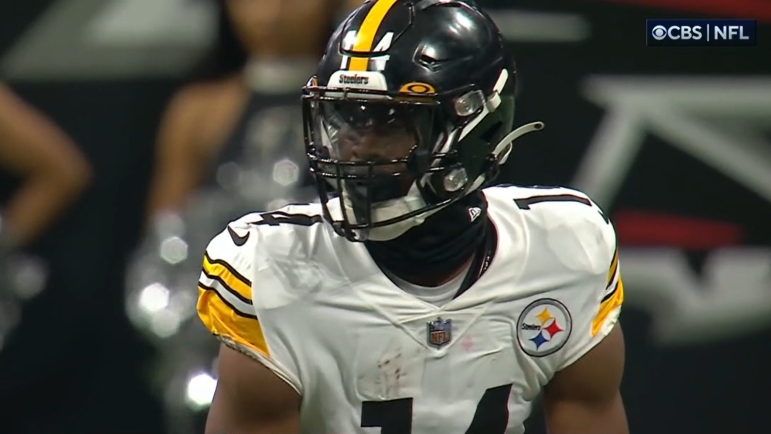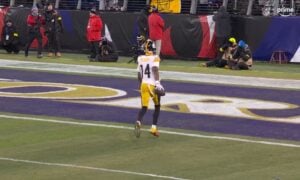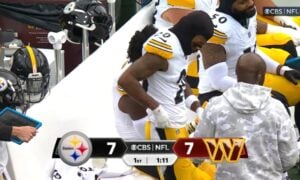Off the top, here’s the truth of it. There’s no smoking gun to why George Pickens saw only two targets against the Atlanta Falcons. No singular “eureka!” answer. No Mystery Machine I’m hopping in with Scooby Doo to go solve it all in a neat and tidy 30 minutes.
Sometimes, receivers just don’t get the ball. It happens.
But with the question being asked, why was Pickens so limited against the Falcons, there’s a couple of explanations. Let’s go through him.
1. Pickens Didn’t Play A Ton Of Snaps
Pickens logged 44 offensive snaps against Atlanta, 68% of the team’s total. The 44 snaps were the fewest he’s played in a game all season while the 68% snap share was also his lowest percentage of the year. So off the top, Pickens didn’t have a high volume of playing time. He only ran 27 total routes, limiting him to a relatively small number of chances.
Pittsburgh relied on heavy personnel in this game using the likes of Zach Gentry (74% snaps against Atlanta, a season-high) and Connor Heyward (22% snaps against Atlanta, most in a game with a healthy TE group) to help establish the ground game. The Steelers used far less 11 personnel than they normally do.
Pittsburgh controlled the game and held the lead throughout. With a run game working, the Steelers ran 37 times, their second-most of the season, Pickens opportunities were more limited. Fewer chances to get the ball, fewer chances you actually get the ball. Pretty simple.
2. His Usage Was A Little Different
Primarily an outside receiver, Pickens played a fair amount in the slot Sunday. 13 of his 27 routes came in the slot, 48.1%. So instead of being his outside/Z receiver who ran vertically, he was running up the seam more often. With the Falcons playing a heavy single-high/middle of the field closed system, those seams balls weren’t there. Pickens didn’t just run deep, there were a couple of underneath/spacing routes but again, the volume just wasn’t there.
3. Atlanta’s Scheme Played A Role
While Pickens’ alignment was a bit different, his route tree was still vertical. And the Falcons, prone to giving up the big play this year, used loose/off zone coverage to keep everything in front. Not many chances to press, especially on Pickens’ trips side, making Pickens a de facto clearout player to open things up underneath. That isn’t always intentional but sometimes a byproduct of how defenses respond. They can take the deep ball away if they want to, sacrificing other things in the process, and that’s what Atlanta chose to do.
Here’s several examples.
4. One Missed Chance
Perhaps Pickens’ best chance to make a play against Atlanta came on this play shown below. On a dagger concept, a seam/dig combination, Pickens was the primary read over the middle. But the Falcons ran a stunt the Steelers didn’t pick up well, forcing Pickett off his spot and flushed to his right instead of drilling the throw to Pickens. Pickett’s pass went for Diontae Johnson, who nearly fumbled, and Pickens is clearly upset here. This was the play he came off the field yelling to get him the ball (with slightly more colorful language).
5. Hidden Factor – Field vs Boundary
Interesting one I picked up on watching the game back and then charted out. First, some terms. The “field side” is the wide side of the field. So if the ball is on the left hash, the field side is the right side of the formation. The boundary is the closed side of the field. So if the ball is on the left hash, the boundary side is the left side of the formation. NFL hashes are more narrow than college but still, it plays a role and most teams align their strength to the field side.
That’s to say this. Of the 27 routes Pickens ran Sunday, 18 of them were to the field side. Only seven of them were to the boundary while on two others, the ball was evenly split between both hashes. So of the 25 where there was a clear field/boundary side, Pickens ran 72% of his routes to the field.
That in itself probably isn’t uncommon. He’s the Z receiver, the strong side receiver who usually aligns to the trips/field side. But what’s interesting is Kenny Pickett spent a fair chunk of the game throwing to the boundary. I charted those too. Several were excluded because the ball was either evenly split between the hashes or several of them didn’t fall into either bucket. I wanted to focus on throws from within the pocket that weren’t designed. So this eliminated boots, one RB screen, and pressures/rollouts where Pickett isn’t picking a side on his own accord.
That left me with 19 throws to the field or boundary. Only nine of these were to the field side, 47.3%. Making 52.6% of them to the boundary.
Restating the key numbers. Pickens ran 72% of his routes to the field side while Pickett threw to the boundary over half the time.
That isn’t a radical difference but when you combine it with everything else, the small volume, how the Falcons covered, and the personnel usage, it adds up and it’s not a surprise to know Pickens had a quiet game. It’s happened before. In Week Two, despite playing 85% of the snaps, he saw just two targets. In Week 8, 86% of the snaps, he saw only three. And in Week 10, 75%, he saw only four.
Big picture, understand Pickens’ role. He’s a Z, vertical receiver in a conservatives, take-care-of-the-ball offense with a rookie quarterback and a run game that’s coming on strong. That doesn’t lend itself to consistency. He’s a feast/famine player and the stats this year, not just the Atlanta game, reflect that. Pickens will have big games, he’ll have quiet games the rest of the year. As he and this offense grows into next year, he’ll find greater consistency. But for now, he’ll need to learn to deal with those kinds of games. Odds are, it’s not his final one.








